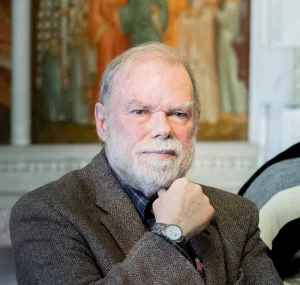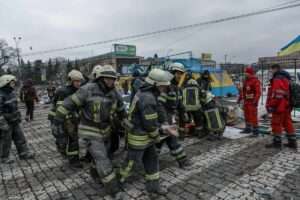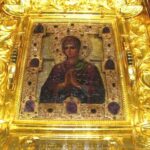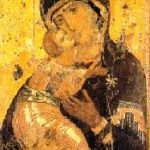Restoring the Diaconate of Women
by Teva Regule
"Master and Lord, You do not reject women who offer themselves, and by divine counsel, to minister as is fitting to your holy houses, but you accept them in the order of ministers. Give the grace of your Holy Spirit to this servant of Yours also, who wishes to offer herself to you, and to accomplish the grace of the diaconate, as You gave the grace of Your diaconate to Phoebe, whom you called to the work of the ministry...."
These are the beginning words of the second prayer of ordination of the female deacon in the Byzantine rite. The female diaconate is a part of our history. For over one thousand years, the Orthodox Church ordained women to serve as deaconesses. As the Orthodox theologian, Dr. Kyriaki Karidoyanes FitzGerald, writes in Women Deacons in the Orthodox Church:
According to Byzantine liturgical texts, the ordination of the woman deacon occurred as any other ordination to major orders. It took place during the celebration of the Eucharist and at the same point in the service that the male deacon was ordained. She was ordained at the altar by the bishop, and later in the service, received Holy Communion at the altar with the other clergy. Depending upon the need, location and situation in history, the deaconess ministered primarily to the women in the community in much the same way that the male deacon ministered to men.... [The order] was gradually de-emphasized sometime after the twelfth century. It should be noted, however, that there does not exist any canon or Church regulation that opposes or suppresses the order."
For over a century, various voices within the Church have called for the restoration of the female diaconate. But what is the diaconate? What is its function in the life of the Church? How has it evolved over time? What did the female deacon do? We know some of the roles of the historical deaconess. Lay women today are filling many of these functions. Is it still necessary to have an ordained ministry? Is a permanent diaconate, especially a female diaconate, needed in the Church today? What could this ministry look like in the 21st century?
The Diaconate in History: The Church's ministry, modeled after Christ's example, grew out of the needs of the community. In the early Church, when the Hellenists complained that their widows were being neglected in the daily distribution of food, the Apostles realized that they could not attend to both the word of God and serve "tables." According to the account in Acts, they sought out "seven men of good standing, full of the Spirit and wisdom, whom we may appoint to this task." This marked both the embryonic beginning of the office of the deacon.
The first place where we find the word "deacon" used as a title is in Romans. St. Paul writing to the Romans says, "I commend to you our sister Phoebe, a deacon (diakonon) of the church at Cenchreae..." The works of Origen and Chrysostom show that patristic tradition upholds Phoebe's position as a deaconess.
In one of the letters from Pliny, Governor of Bithynia, to the Emperor Trajan (112 AD), Pliny asks for guidance on how to handle the Christian sect, writing that he had to place "two women called >deaconesses' under torture."
We have a general understanding of the functions of the male and female deacon from early church documents. Each was answerable to the bishop. The male deacons ministered to men while the female deacons ministered to women. Each also had a liturgical role, although there is disagreement as to their precise functions. This parallelism can be seen in the Apostolic Constitutions passage that outlines the character of the deacon:
Let the deacons be in all things unspotted, as the bishop himself is to be, only more active; ...that they may minister to the infirm.... And let the deaconess be diligent in taking care of the women; but both of them ready to carry messages, to travel about, to minister, and to serve...
This reflects an earlier understanding of the functions of the office found in the Didascalia Apostolorum. The Didascalia contains sections on the character of the deaconess and her ministry of assisting in the baptism of women and instruction of women converts.
During the Byzantine period, the diaconal office in the east, especially that of women, flourished, as we see this in the many women deacon saints on the calendar, including Sts. Macrina, sister of Sts. Gregory and Basil (July 19), Nonna, wife of St. Gregory of Nazianzus (August 5), Olympias, friend and confidant of John Chrysostom (July 25), Xenia "the merciful" (Jan 24), and Irene of Chrysovalantou (July 28) We also have descriptions of the makeup of the clergy serving during the Liturgy at Hagia Sophia, including "forty deaconesses."
During this time, the male diaconate in the East grew in prominence, holding high positions in church governance, including participating in the Ecumenical councils (e.g. Athanasius of Alexandria, a deacon, was secretary for his bishop at the Council of Nicaea in 325). They also served as emissaries and ambassadors of the episcopal seat in diplomatic matters and were administers of church-run homes for the poor and widows, orphanages, and hospitals.
The order of the female diaconate began to decline sometime after the twelfth century. There were fewer adult baptisms so female deacons were no longer needed at initiation. In addition, in late Byzantium the rise of influence of Levitical rules, especially regarding women, led to the perception that the shedding of blood made a woman Aunclean" and therefore, unable to enter the sanctuary or participate in the liturgical life of the Church, though this was in direct contradiction to the understanding of >uncleanness' found in the Didascalia Apostolorum and the Apostolic Constitutions. Chapter 26 of the Didascalia admonishes Christians to abandon the rabbinical rules of 'uncleanness': "Are they devoid of the Holy Spirit? For through baptism they receive the Holy Spirit, who is ever with those that work righteousness, and does not depart from them by reason of natural issues and the intercourse of marriage, but is ever and always with those who possess Him..."
The Apostolic Constitutions extends this emphasis: "For neither the lawful mixture [intercourse], nor childbearing, nor the menstrual purgation, nor nocturnal pollution can defile the nature of a [person], or separate the Holy Spirit from him.... but only impiety towards God, transgression, and injustice towards one's neighbor..."
With the rise of Islam and the subsequent fall of the Eastern part of the Roman empire to the Ottomans, the Church turned inward. It could no longer participate in many of the philanthropic aspects of its ministry. Moreover, many of the traditional duties of the male deacon were being assumed by the priest and by the growing number of those in the so-called "minor orders." This led to the position of the diaconate being perceived as more of a "transitional" one along the way to being ordained a presbyter. Although the male deacon retained his role in the liturgical assembly, the office had devolved greatly. Unfortunately, this is what typically remains of the order in the East today.
Modern Renewal of the Office: In modern times, the diaconate has experienced a renewal and rejuvenation, most notably (and somewhat ironically) in the Western Christian churches. While this movement is due mostly to the needs of the local churches, it is instructive to us, as Orthodox Christians, to realize that the theological reasoning and justification for a re-institution of the order came from careful study of the Early Church, primarily its expression in the East.
Although the diaconate in the Eastern Orthodox Church has remained an active ministry since apostolic times, its scope and function have greatly diminished since the fall of Byzantium. The male diaconate generally functions solely in the liturgical realm and, oftentimes, is only a transitional stage on the way to ordination to the presbytery. The female diaconate has virtually disappeared.
There have been numerous attempts for over 150 years to reinstitute the female diaconate. As early as 1855, the sister of Czar Nicholas I tried to restore the office. Other prominent Russians also lobbied for its restoration, including Aleksandr Gumilevsky and Mother Catherine (Countess Efimovsky). In 1905-06, several bishops, archbishops, and metropolitans of the Russian Orthodox Church encouraged the effort. This issue was to be a major topic at the Council of the Russian Church beginning in 1917, but due to the political turmoil in Russia at the time, the council's work was not suspended. (Other items on the agenda included adopting the use of the vernacular in the liturgical services and the reinstitution of the married episcopacy.)
Other efforts were made in Greece. On Pentecost Sunday in 1911, Archbishop (now Saint) Nektarios ordained a nun to the diaconate to serve the needs of the monastery. A few years later, Archbishop Chrysostomos of Athens appointed Amonastic 'deaconesses,' nuns in fact appointed to the subdiaconate.
More recently, the issue has been discussed at the international conferences for Orthodox women in Agapia, Romania in 1976 (at which its restoration was unanimously recommended), Sophia, Bulgaria in 1987, Rhodes, Greece in 1988), Crete in 1990, Damascus, Syria in 1996 and Istanbul in 1997.
In July of 2000, after over a year of careful review of the subject, a letter was sent to the Ecumenical Patriarch by more than a dozen members of the Orthodox community in Paris, among them Elisabeth Behr-Sigel, Fr. Boris Bobrinskoy, Olivier Clément, and Nicolas Lossky. The letter notes that the Patriarch himself has stated that there is Ano obstacle in canon law [that] stands in the way of the ordination of women to the diaconate. This institution of the early Church deserves to be revitalized." It also states that the order should Ainvolve more than a simple and archaeological reconstitution of the ancient ministry of the deaconesses ... It is a question of its revitalization ... in the context of the ... present day."
What would the deaconess do in the Church today? The question is generally preceded by the acknowledgment that the ancient deaconess assisted in the baptism of women, etc. It is oftentimes assumed that since we no longer have many adult baptisms (infant baptism being the norm) that we no longer need deaconesses. (Although a simplistic analogy, it is interesting that the same question is not asked of the male diaconate. i.e. Since we no longer need 'table servers' at the Eucharist, a function of the biblical diaconate, why do we need male deacons?) This issue has been discussed within Orthodox circles as well. According to the report of the Crete consultation (1990), a deacon or deaconess could
lead people in prayer, give spiritual counsel, distribute Holy Communion where possible. The renewal of the diaconate for both men and women would meet many of the needs of the Church in a changing world... catechetical work... pastoral relations... serving the same needs for monastic communities without a presbyter ... reading prayers for special occasions, ...performing social work ... pastoral care ... engaging in youth and college ministry ... counseling ... anointing the infirm ...carrying out missionary work ... ministering to the sick, ... assisting the bishop or presbyter in the liturgical services....
The report concludes that a creative restoration of the diaconate for women, could lead in turn to the renewal in the diaconate for men as well.
The Liturgical Role of the Female Deacon: When discussing the reinstitution of the female diaconate, the question of her liturgical role, including her service within the altar area, often arises. It is my opinion, if this question were settled, we would currently have women deacons in the Orthodox Church.
According to the First Apology of Justin the Martyr (100-165 AD), the ministry of the deacon was expressed in the liturgical celebration of the gathered assembly gathered for the Eucharist,
reading the Gospel, leading the intercessions of the people, receiving the gifts of the people and 'setting the table' for the meal, serving the Eucharistic meal.... [Moreover] the social service carried on by the deacons seems to be been rooted in the liturgical celebration.
As we have seen, the link between liturgy and service is crucial not only to the office of the diaconate, but to our understanding of what it means to gather as Church in worship. It is in our service to the other that we are united with them. Our service to the other brings them with us to worship. We are their visible representatives.
Although the liturgy enables us to encounter God in a variety of ways and at differing levels, allowing us to experience a "taste of the Kingdom," we must always remember that we are not fully, as yet, in the eschaton (end times). We live in the here and now and are called to draw all closer to God. In my opinion, it is a distortion of the office to have the male deacon serve only during the liturgy, but not within the community, and conversely, to have a future female deacon serve within the community, but not during the liturgy.
As Dr. FitzGerald says in her book, Women Deacons in the Orthodox Church:
It is important to remember that in the past women deacons did have important responsibilities in the Eucharistic assembly as well as in the administration of baptism, in praying with and for those in need, and in bringing Holy Communion to those unable to attend the Eucharist. ... Today, these expressions of ministry can certainly continue. At the same time, we also need to examine how women deacons can participate in the Eucharist and other liturgical services in a manner which is expressive of the living Tradition of the Church and which is not defined by cultural norms of another time.
Need? But do we really need a rejuvenated diaconate and, in particular, a restored female diaconate? To help answer this question, it is instructive to understand the responsibilities of a typical parish priest.
Fr. Alexander Garklavs outlined a number of functions expected of today's parish priest in his presentation at the 2004 Pastoral Conference held at St. Tikhon's Monastery in June 2004. In additional to all the liturgical duties of the priest (Sunday and any daily liturgical services, baptisms, weddings, funerals, etc.), he enumerates some of the priest's responsibilities in parish life, including pastoral visitations, educational work, Bible study, adult study, youth work, teen work, working with choirs and choir directors, marriage preparation, marital counseling, visiting shut-ins, grief counseling, hospital visits, office work, preparing and printing bulletins and schedules, parish mailings, aspects of parish administration, etc.
In 1953, Archbishop Michael of the Greek Orthodox Church in North and South America realized that there is so much to do in each community that
the endeavors of these priests alone do not suffice. For should the priest wish to know, as he must, his spiritual children by name, their problems, and their spiritual and moral needs, this would certainly be beyond his physical and spiritual resources. These tremendous needs of the Greek Orthodox Church in America has urged us to make a fervent appeal such as this to our daughters-in-Christ... With the future welfare of our Church and membership at heart, we are considering the establishment in this country of an order of deaconess.
Clearly, a rejuvenated diaconate, a ministry that has service as its primary focus, is necessary in our Church today. No one person can fill all the duties necessary for the building up of the Body of Christ, the Church. As Paul says in 1 Corinthians, AEach of us has been given the manifestation of the Spirit for the common good." The diaconate is not merely a Astepping stone" to higher orders. It is, as Dr. FitzGerald explains, Aa full and parallel order of ordained ministry to which both men and women are called by God."
But is an ordained ministry necessary? It is an unfortunate effect of clericalism that lay participation in our churches varies widely. This is especially true of the participation of women. The range of women's participation in the life of the Church can vary from diocese to diocese and even from parish to parish within each diocese. Still, many laywomen are already doing diaconal work in our parishes.
What does an Aordination" mean? To begin to answer these questions, it is important to remember that we are all called to ministry within the Body of Christ. Each of us is called to minister to others in our daily lives C we are all expected to teach others, especially those in our care. And yet, we set apart certain people to undertake certain care tasks on a professional basis. Unlike us, they must be trained in their profession and pass exams before we, as a society, confer a designation on them as Ateacher" or Amedical professional." Likewise, throughout history the Church has Aset apart" those Aconsecrated for service."
The female deacon in the 21st century... The Church is blessed to have a number of laywomen working in diaconal roles already, including pastoral assistants, chaplains, ecclesiarchs, and monastics. Through conversations and reflection, I have collected some of their experiences that I would like to share with just one with you. In this instance I was interviewing a woman serving as a hospital chaplain:
The first time I was scheduled to serve over night as an on-call chaplain, I received a page at 5 AM. I groggily called the Intensive Care Unit, and spoke to a nurse who requested that I visit an anxious, weeping patient who would be undergoing surgery later that morning. I was told that the patient, "Andrew" was Orthodox Jewish. The nurse said that Andrea had a tracheotomy, and therefore could not speak. I entered the small ICU, which was silent but for the beeping ventilator and monitors. I introduced myself to Andrew, a 50-year old man with a scraggly beard and dark eyes. I told him that I would be happy to sit with him in this time of anxiety, and pray with him if he desired. AI understand you are Jewish," I said, thinking that I might try to locate his rabbi if he had specific religious needs. He shook his head, and began awkwardly attempting to cross himself in an Orthodox manner. "Oh!", I said, "You're Orthodox!" Apparently, he had been misunderstood. "Actually, so am I!" I said. His eyes registered surprise and joy, and he began crying calmer, gentler tears. He took a pad and wrote in large, shaky letters, "I am Orthodox. I am scared." I put my hand on his shoulder and consoled him, and after a short conversation, via the notepad, about his surgery and his fears, I offered to pray for him. I taped an icon of the Resurrection on the wall across from his bed, and standing beside him, chanted the Trisagion prayers and a Psalm. Andrew became visibly calmer; a sense of peace came over his face. He left for surgery, trusting in God's protection. I did not see Andrew again, but I believe that God led me to him on that early morning, to ease his fears and to refocus his heart on God's loving presence in a time of suffering.
Consider how much more complete would this story have been if, having been ordained to the diaconate, the chaplain could have brought communion to this afflicted, ailing and frightened man?
It is my hope that the Church will not only restore the ordained female diaconate, but revitalize the office, encouraging women to serve within the community and the Liturgy B borrowing the words of Elisabeth Behr-Sigel of blessed memory B in the Acontext of the culture and present requirements of the day."
* * *
Teva Regule has completed her Master of Divinity degree at Holy Cross Greek Orthodox School of Theology and is now pursuing a second level master's degree in liturgical theology. She is managing editor of the St. Nina Quarterly (www.stnina.org). This is an abridged version of a paper presented at the Orthodox Peace Fellowship Conference held in Maryland in September. The full text, with footnotes, is on the OPF web site in the Resources section.
❖
Fall 2008 issue of In Communion / IC 51










